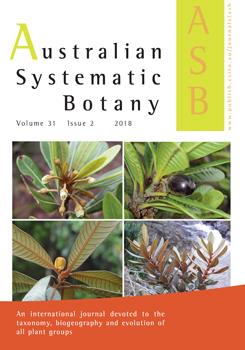Ver ítem
- xmlui.general.dspace_homeCentros e Institutos de InvestigaciónCIRN. Centro de Investigaciones de Recursos NaturalesInstituto de Recursos BiológicosArtículos científicosxmlui.ArtifactBrowser.ItemViewer.trail
- Inicio
- Centros e Institutos de Investigación
- CIRN. Centro de Investigaciones de Recursos Naturales
- Instituto de Recursos Biológicos
- Artículos científicos
- Ver ítem
Cytogeography and morphological characterisation of a taxonomic, polyploid complex of Mimosa (Leguminosae) from subtropical South America
Resumen
Mimosa subseries Dolentes Barneby and Brevipedes Barneby are ecologically and morphologically high-diversified infrageneric taxa of this genus in southern South America. We performed a cytogenetical and morphological analysis of both subseries. Chromosome numbers from accessions throughout the area of distribution were studied. The chromosome numbers 2n = 8x = 104 for M. dolens subsp. callosa (Benth.) Barneby, M. dolens subsp. acerba varieties acerba
[ver mas...]
Mimosa subseries Dolentes Barneby and Brevipedes Barneby are ecologically and morphologically high-diversified infrageneric taxa of this genus in southern South America. We performed a cytogenetical and morphological analysis of both subseries. Chromosome numbers from accessions throughout the area of distribution were studied. The chromosome numbers 2n = 8x = 104 for M. dolens subsp. callosa (Benth.) Barneby, M. dolens subsp. acerba varieties acerba (Benth.) Barneby, latifolia (Benth.) Barneby and rudis (Benth.) Barneby, M. dolens subsp. rigida var. rigescens (Benth.) Barneby, var. anisitsii (Lindm.) Barneby and var. foliolosa (Benth.) Barneby; and 2n = 4x = 52 for M. sceptrum Barneby, M. aff. custodis Barneby and M. dolens var. pangloea Barneby are presented for the first time. Their karyotypes were symmetric, with small chromosomes. There were several areas with taxa growing in sympatry, occasionally with intermediate forms. No diploids were found, which suggests the presence of either a declining polyploid complex or ancient polyploidy in the clade of southernmost representatives of M. series Mimosa, the most derived of the genus. Some vegetative, inflorescence and carpological characters seem to be associated with chromosome duplication. The distribution pattern of the cytotypes suggests events of chromosome duplication in centres of diversity and expansion of octoploids to the southernmost areas of distribution. Our findings support the importance of polyploidy in the morphological diversity, distribution and speciation of this complex.
[Cerrar]

Autor
Morales, Matias;
Fradkin, Eduardo;
Bessega, Cecilia Fabiana;
Poggio, Lidia;
Fortunato, Renee Hersilia;
Fuente
Australian Systematic Botany 31 (2) : 190-208. (2018)
Fecha
2018
Editorial
CSIRO Publishing
ISSN
1030-1887
1446-5701
1446-5701
Formato
pdf
Tipo de documento
artículo
Palabras Claves
Derechos de acceso
Restringido
 Excepto donde se diga explicitamente, este item se publica bajo la siguiente descripción: Creative Commons Attribution-NonCommercial-ShareAlike 2.5 Unported (CC BY-NC-SA 2.5)
Excepto donde se diga explicitamente, este item se publica bajo la siguiente descripción: Creative Commons Attribution-NonCommercial-ShareAlike 2.5 Unported (CC BY-NC-SA 2.5)

